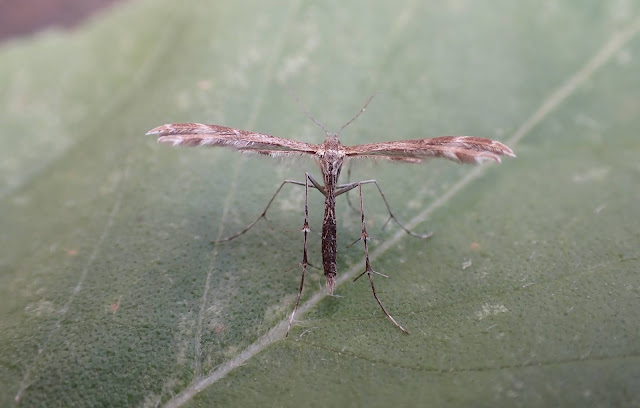2020, what a year. Terrible in so many ways but mothing provided some respite during the lockdowns and beyond. I was restricted to home working from early March onwards and with commuting time removed from my week days, the trap went on at regular intervals.
The weather, in the main, was good too. All this combined to make my most successful garden mothing year to date. I recorded some superb species that I had barely thought possible to find here and the total number of species was mind blowing. I can't see me being able to get close to this again, although the restrictions put on movement in 2020 look like continuing deep into 2021, so we'll see
The key numbers:
Number of Species Recorded: 488
Lifers: 44
New for Cottenham: 54
New for for the garden: 69
New moths for VC29: 1*
High Street List at end of 2020: 623
Cottenham List: 684
8The total of 487 species by far beats the previous record of 422 in 2018 and is the third year in a row I have recorded over 400 species. The new moth for VC29 refers to Scythris limbella which I trapped in late July - this might be better termed the first modern day record for the vice county though to be honest as there appears to be a record from early last century. I trapped a second (or the same) individual 10 days later.
One of the most interesting aspects of the year was the appearance of several species of tricky Phyllonorycter leaf mining moths. I had recorded precisely zero species from this genus in the garden previously apart from the related and abundant Horse Chestnut Leaf Miner. Amazingly the garden now has 5 species from this genus on the list while there were a handful of others that couldn't be identified to species level. All this interest led me to the uncharted waters of looking at leaf mines to try and work out sources of the adult moths.
Personal highlights of the year were the two Catolcala species - the amazing Clifden Nonpareil which turned up twice while a Dark Crimson Underwing occurred in early September. In fact both species were present on that morning in September, so making it one of my best trap nights ever. Dark Crimson Underwing hadn't been recorded in the VC at all before 2020 and there were a handful of records before mine.
I've enjoyed luring clearwing moths in to the garden for several years now but after failing to get a Hornet Moth over several years of effort, I thought I had reached the end for potential new species. That changed with a bang in 2020 with the advent of a new lure for Lunar Hornet Moth. After a couple of failed attempts, a superb moth came in. Not stopping there I recorded 3 Raspberry Clearwings in July, another new species to me and one thought didn't in this part of the County. I was very happy to be wrong about that! So will 2021 finally bring that Hornet Moth or will Sallow Clearwing be possible over this way?
Further micro moth highlights in 2020, included two rare plume species: Dingy White in July and Breckland in September. The pyralid Matilella fusca I trapped in May was a county second while I also recorded another Sciota adelphella - the third for the county and all of them have been here!
Noctuid highlights included my first Alder Moth in May and an excellent Marbled Clover in July. Geometers included a fine Blotched Emerald in June that escaped without being photographed. Hopefully I'll get another chance at that one so to put the frustration to bed.
The full list of new for the garden moths from 2020, in reverse order of appearance, is as follows (with lifers in bold):
The Sprawler
The Chestnut
Mottled Umber
Spilonota laricana
Breckland Plume
Deep-brown Dart
Dark Crimson Underwing
Bordered Beauty
Toadflax Pug
Clifden Nonpareil
Dichrorampha acuminatana
Bucculatrix thoracella
Phyllonorycter quercifoliella
Prays fraxinella
Cochylidia implicitana
Dusky Thorn
Gypsy Moth
Phyllocnistis unipunctella
Scythris limbella
Clavigesta purdeyi
Dingy White Plume
Lesser-spotted Pinion
Phyllonorycter harrisella
Phylloncnistis xenia
Cochylis dubitana
Raspberry Clearwing
Nettle-tap
Marbled Clover
Gynnidomorpha alismana
Gypsonoma minutana
Phyllonorycter comparella
Caloptilia rufipennella
Epagoge grotiana
Notocelia roborana
Lunar Hornet Moth
Endothenia marginana
Epinotia abbreviana
Brown Scallop
Ethmia dodecea
Dotted Fan-foot
Aethes dilucidana
Brown Oak Totrix
Clay Triple-lines
Phyllonorycter leucographella
Blotched Emerald
Paraswammerdamia albicapitella
Coleophora mayrella
Cydia nigricana
Sandy Carpet
Matilella fusca
The Spinach
Pale Oak Beauty
Phyllonrycter viminiella
Ethmia quadrillella
Stigmella salicis
Glyphipterix simplicella
Brachmia inornatella
Pseudococcyx turionella
Alder Moth
Bucculatrix bechsteinella
Clouded-bordered Brindle
Tischeria ekebladella
Elachista apicipunctella
Scrobipalpa acuminatella
Agonopterix scopariella
Oak-tree Pug
Incurvaria masculella
Lead-coloured Drab
Winter Moth

















































